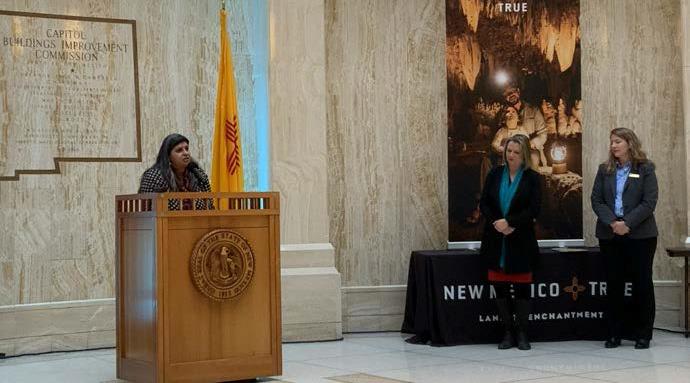Diego Lopez - CC Teresa Martinez, Continental Divide Trail Coalition Executive Director, stands at a podium in the rotunda of the Roundhouse in Santa Fe, to her left stands New Mexico Lands Commissioner Stephanie Garcia Richards and BLM New Mexico State Director Melanie Barns. The three spoke after an hour-long presentation of New Mexico’s culture in the rotunda. The Feb. 6 speech came to present big changes to the Continental Divide Trail, especially the parts through Cibola County off Highway 53. All three entities announced that the trail will be getting an overhaul through the state to encourage and make it easier for hikers to enjoy the recreation of New Mexico, and benefit the economy of communities along the trail like Cibola County.
SANTA FE, NM – Cibola County is expected to see a massive boon to its recreational economy over the next several years after an announcement at the New Mexico State Capitol on February 6. The announcement was to combine the resources of the New Mexico Land Office, federal Bureau of Land Management, and the Continetal Divide Trail Coalition. This will open up federal funds which will be used to clear easments and make the trail easier to access for all people.
“We like to say that the State Land Office is open for adventure, and that has never been truer than it is today as this partnership will significantly improve access to one of the world’s most beloved thru-hike trails,” said New Mexico Commissioner of Public Lands Stephanie Garcia Richard. “When I created the Office of Outdoor Recreation within the State Land Office, achievements like these were the goal. Outdoor recreation is an essential part of who we are as New Mexicans, and the Continental Divide Trail brings thousands to our beautiful state every year. I’m proud that we were able to work so closely with our partners at the BLM and CDTC to make this partnership a reality.” Commissioner Garcia Richards went on to say that since taking office, she has made it her priority to open up as many of New Mexico’s public lands as possible, and that this effort will further increase accessibility to the public lands while leveraging the state’s public lands to increase the outdoor recreation and boost local economies of all communities on the trail.
Notably, the Cibola Citizen only discovered representatives from Acoma Pueblo and Zuni Pueblo at this announcement. Feb. 6 was tourism day at the legislature. Communities from across New Mexico were present with their local officials and local bands and dancers to show off their community’s culture and commitment to statewide recreation. Zuni Pueblo had a group of traditional dancers perform, but no other acts from Cibola County were present. No local elected officials were present for this meeting, which was noted by BLM NM Director Melanie Barns after the announcement when speaking about the impacts to Cibola County.
Barns said that the trail needs work to make it more accessible across the state, but that Cibola County has several portions of the trail on Highway 53 that need to be refurbished. Easements have been secured to take the trail at least partly off the highway and increase access to the trail for all hikers.
In their announcement, the joint coalition stated that hikers will no longer need to purchase or acquire permits to hike the trail. This will allow more hikers to pass through the Continental Divide in New Mexico, and further improve the economy of the state by making the trail more attractive. “Before the acquisition of the right-of-way, the State Land Office would provide the CDTC with permits to issue to CDNST hikers, allowing them to lawfully cross state land as they trek the trail. The right-of-way acquired by BLM New Mexico removes the need for hikers to obtain an extra permit to access the CDNST. The right-of-way will also enable the BLM to maintain the trail and make improvements passing through state land. These improvements are designed with multi-use principles in mind, thus improving the trail experience for hikers while mindful of the needs of New Mexico’s agricultural users,” Commissioner Garcia Richard’s office announced in a statement.
BLM Director Barns said that this project has taken seven years to get off the ground, and it included opportunities for people living along the trail to give their opinions, as well as contacting 22 indigenous tribes along the trail, with only three responses from the Hopi Tribe, White Mountain Apache Tribe, and the Comanche Nation. Continental Divide Trail Coalition Executive Director Teresa Martinez said that the project has been in the works for much longer, saying this project was 18 years in the making. She thanked the State of New Mexico and the BLM for working tirelessly to accomplish what she called, “innovation” for the trail. She mentioned that New Mexico is leading the way, as it usually does, she remarked, with the development of continental divide.
Thanks to the partnership between the State Land Office, Bureau of Land Management, and Continental Divide Trail Coalition, federal funds will be opened up that will allow for better trail maintenance and development. Commissioner Garcia Richards told the Cibola Citizen that some negotiations with ranchers still need to be held to make sure that the transition to increased access of Continental Divide is equitable.
According to Commissioner Garcia Richards, 97 percent of business owners on or along the trail have said that hikers on the Continental Divide have been an asset to their businesses and they support expanding and enhancing the trail.

